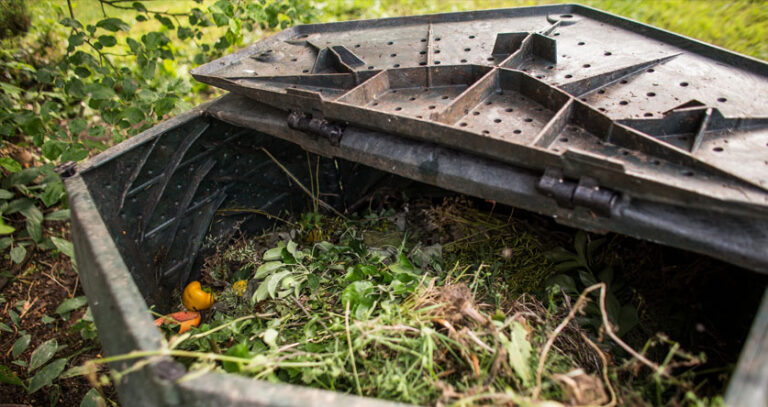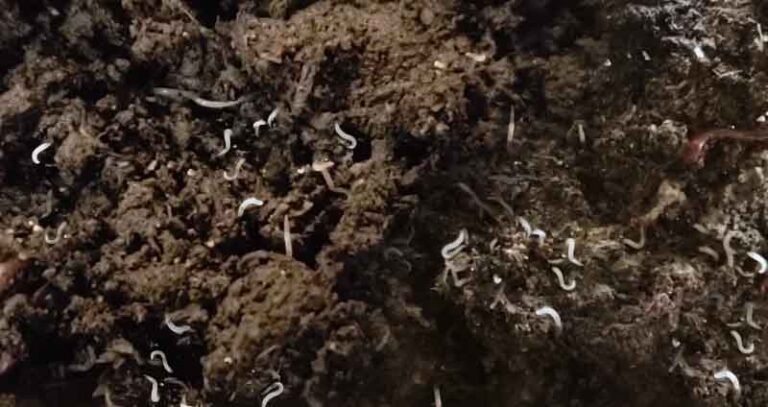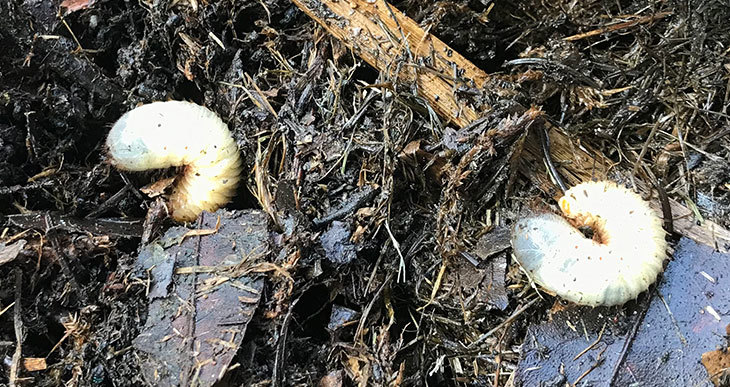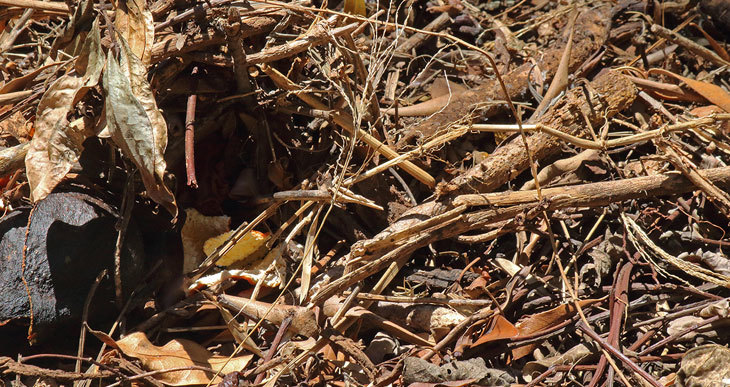How to Turn Compost (And Get Quicker Results)

The act of turning compost can mean the difference between finished compost in just a few months, or waiting much longer for decomposition to happen. Turning influences composting speed, but it can also help resolve a number of common composting problems.
And most of us want good quality compost quicker… Right ?
So, in the following lines I’ll explain exactly why, how, and when you need to turn compost, so you can start using the products of your compost bin for the benefit of your garden.
Quicker!
All you need is a bit of observation and common sense to achieve a good turning schedule.
What does turning compost mean?
Turning compost is the term used to describe mixing compost ingredients, breaking apart and redistributing compacted materials, and in the process adding air pockets.
But why do you have to turn compost?
You need to “turn” compost to improve aeration and oxygen supply, and redistribute non-depleted material for a more uniform composting process.
It’s all about oxygen !
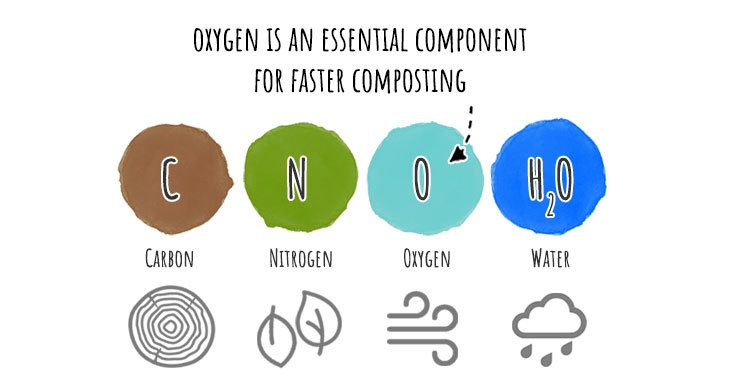
When you add organic matter to your compost it begins to decompose. This rotting process happens thanks to the work of millions of helpful microbes which feed off the raw materials and slowly transform them into compost.
But these helpful little critters also need air to function properly.
This is where “turning” becomes useful.
In the beginning, compost includes plenty of space for air to circulate. As you add more things to your compost, the weight compresses the layers of organic matter and the air pockets shrink.
Turning (sometimes referred to as aerating) helps introduce air back into the pile.
Also, composting materials tend to decompose at different rates throughout the pile. In general, the core of the heap tends to heat up quickly at the beginning of the process. As the microbes get to work, they generate heat and use up any available oxygen.
Turning the compost allows you to transfer undepleted organic material back into the mix so the fast-acting microorganisms can carry on their work.
So the overall objective is this…
To create the best conditions for composting organisms to thrive, so they can decompose organic materials as fast as possible.
Another good reason for turning compost is to avoid foul odors which result from unoxygenated compost… more about this below.
Do you need to turn compost?
Turning compost is not essential. Even if you don’t turn a compost pile the organic material will still decompose and transform into compost. Eventually!
The key issue is the time it takes to transform the raw organic matter.
The most active and efficient microorganisms are aerobic (oxygen-loving). These fast-acting bacteria will die from lack of oxygen if there’s no air left to consume.
This doesn’t mean that everything stops rotting. The aerobic microbes are replaced by anaerobic organisms (oxygen-hating), and the decomposition process continues.
The drawback is that these anaerobic critters tend to let off bad-smelling gases, and they are much slower. (Related reading: “about smelly compost”.)
In fact, when a pile turns anaerobic decomposition slows down by up to 90%.
As you can see, oxygen is an essential ingredient for efficient composting. This is why turning is a recommended operation in most situations. Turning will help you get finished compost faster.
I say most situations because you can also design composting systems that require little or no effort. This practice is known as cold composting.
How often to turn compost?
Compost needs to be turned at strategic times. Whether or not to turn compost depends on a few different factors such as the green to brown ratio, the stage of decomposition, moisture levels, or even the type and size of compost bin you use.
Sorry to disappoint you…
But there’s no hard and fast rule for turning compost. It’s not like “turn your compost once per week” is the ultimate guideline.
When to turn compost depends first and foremost on the type of organic matter you include.
Green materials are nitrogen-rich things like grass clippings, fresh leaf trimmings, weeds, vegetable and fruit scraps, etc. These kinds of substances are processed by fast acting bacteria which use up oxygen quickly.
This means green content will need turning more often to reintroduce air and keep the pile well ventilated.
Brown materials on the other hand are hard, coarse, woody items like twigs and branches, wood chips, hay, shredded cardboard, dried leaves, etc. These are decomposed by slower-acting organisms and fungi, and the microbial population tends to be much lower.
Brown material therefore needs turning less frequently.
Moisture content is also an important factor. The ideal moisture conditions are 40-60%.
Not too wet, and not too dry.
Too much moisture means that the empty spaces which normally provide air are taken up by water molecules. Turning wet compost increases ventilation, allows some evaporation, and helps bring moisture levels back to normal.
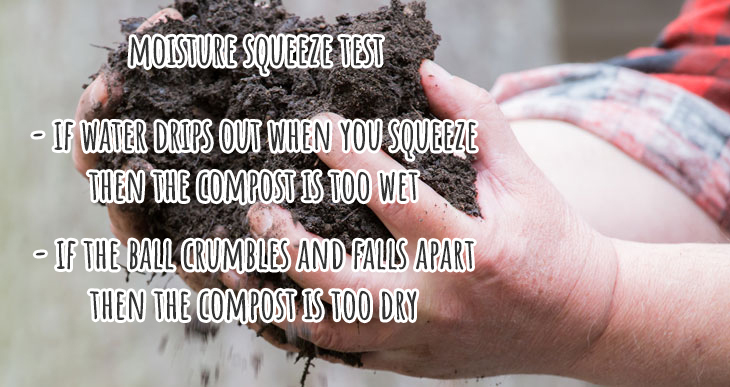
The “sponge/squeeze test”: The most common method for testing moisture levels is to take a handful of compost from the middle of the heap and squeeze it. It should have the feel of a wrung-out sponge. Alternatively, you can use a compost moisture meter like this one… (Amazon).
So as you can see, the rate at which you turn your pile depends on the balance of stuff you put in, and how wet it is !
Most of us include different types of materials at different moments. And this can vary throughout the year depending on the season. Assuming you add mixed garden refuse and kitchen waste to your bin, my suggested turning schedule would be something like this:
- Begin by gauging the moisture level.
- If the compost mixture is very wet (70% or above), turn every day until the moisture level comes down to normal.
- If the compost is too dry (below 40%), add some water!
- Once compost hits about 40-60% moisture levels, try turning every 2 to 3 days. Do this 4 or 5 times for the first two weeks.
- You can then manage the pile periodically, turning every week or so.
- Eventually most composters stop turning a pile and let it sit. This allows longer acting microorganisms and fungi to inhabit the compost which are the best things for breaking down woody substances and branches. These are best left undisturbed so that you don’t break up the fungal network. Otherwise they have to start over again.

You could probably get away with turning less frequently than every 2-3 days, and still avoid anaerobic conditions, but your compost would not heat up as much, and the process would be slower.
How to turn compost
Depending on the type of composting system you use, here are a few suggested methods for turning compost.
A good old fashioned pitchfork and elbow grease is the best way to turn your compost pile. You should turn the center of the pile out and move the materials from the outside of the pile toward the center. This will reactivate the heating process with the new materials.
You can remove the compost from your bin and then replace it layer by layer. If you have new waste materials to throw in, you can incorporate them between the layers as you shovel everything back in.
Using a multi-bin system, you can turn your compost by moving it from one bin to another. This prevents having to shovel everything out of the bin and then put it back in. Instead, you just move the compost from one place to another, and you’re done.
A compost aerator like this one on Amazon, is a clever tool to help add the necessary air channels to your compost bin without having to go to the trouble of fully turning it. You simply push the aerator down into the compost and turn it in order to fluff up the material. This doesn’t bring the materials from the outside to the middle as efficiently, but it’s an easier solution to turning.
What can I use to turn my compost? Note that a compost aerator or crank is a popular tool for adding air back into a pile. But keep in mind that this is only good for adding air pockets, but not very good for redistributing any non-depleted organic matter. To mix things up properly, you’re probably going to need a pitchfork!
A compost tumbler is perfect for shortening turning time and effort. These bins are made with a rotating barrel that just needs to be turned over. The materials inside will get turned as well, no pitchfork required.
Compost Tumblers
Compost in a tumbler is generally easier to turn, as they incorporate a crank specifically to get the job done. Tumblers should be turned at least every few days, two to three times a week, to keep the decomposition process running smoothly.
Regularly turning a tumbler will help to regulate the moisture inside of the enclosed environment caused by the quick heating compost. It also keeps the compost well aerated for the organisms that require oxygen to break down your materials.
For a lot of people, a compost tumbler is a great investment, as it eliminates the need to use a tool to turn a compost pile by hand.
Can you turn compost too much?
If you turn compost too frequently you can disturb the moisture balance in the heap, causing it to dry out. You should only turn compost daily if it’s too wet. Turning too much can also interrupt the growth of fungi and actinomycetes. In piles that are left for at least 2 or 3 days these organisms form a nice unbroken thick layer.
What happens if you don’t turn compost?
Any number of problems can crop up if you don’t incorporate enough oxygen by turning.
In the table below you will see some common compost problems, where turning can be beneficial:
Note: If viewing on phone, please swipe the table to scroll horizontally.
| If your compost… | Then it probably… |
So you should… |
|---|---|---|
Smells sour | Contains Too Many Green Materials | Add More Brown Materials and Turn to Mix |
Smells Like Ammonia | Has Gone Anaerobic | Turn to Incorporate More Air (and add more brown materials if it seems too wet) |
Won’t Heat Up | Doesn’t Have Enough Oxygen | Turn to Incorporate More Air |
Doesn’t Have Enough Nitrogen (Green Materials) | Add More Green Materials and Turn to Mix | |
Is Too Wet | Add More Brown Materials and Turn to Mix | |
Is Too Dry | Water the Pile, Turning to Disperse Moisture | |
Is Over 160° | Is Overheating | Turn the Pile to Cool it Off |
Is Attracting Pests | Has Exposed Food Scraps | Turn to Mix Food Scraps Well or Hide Them in the Center of the Pile Under a Layer of Brown Materials |
No turn compost (cold composting)
So what if you just don’t want to bother turning compost ?
If you’re looking for a hands-off approach and you don’t need the compost quick, you can always go this direction and skip the turning altogether.
Just as the name suggests, cold compost doesn’t heat up in the same way that hot compost does. This is mainly due to the lack of turning, which means these compost piles rely on anaerobic organisms to do the decomposing.
Keep in mind, you will be waiting much longer for your compost. Cold compost can take up to a year or even longer, depending on weather conditions to finish. This is because anaerobic organisms are sluggish and take a while to break down organic materials.
You may also find that your compost doesn’t exactly smell like flowers. Anaerobic organisms produce hydrogen sulfide, which results in the smell of rotten eggs.
This method of making compost will eventually result in the product you want, and all you really have to do is wait.
Turn Out Your Compost Faster
Turning your compost certainly isn’t necessary, although it is recommended.
The number one reason for regularly turning your compost is to create a finished product faster and more efficiently.
It certainly helps the process moving along. If you have the time and energy available, you should definitely incorporate this practice into your composting.


